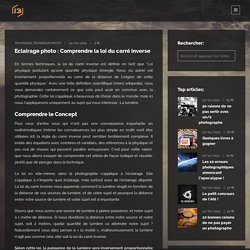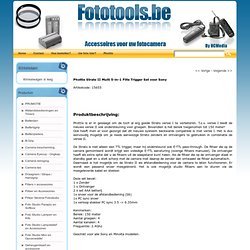

Eclairage photo : Comprendre la loi du carré inverse. Eclairage photo : Comprendre la loi du carré inverse En termes techniques, la loi du carré inverse est définie en tant que “Loi physique postulant qu’une quantité physique (énergie, force, ou autre) est inversement proportionnelle au carré de la distance de l’origine de cette quantité physique.”

Avec une telle définition scientifique (merci wikipedia), vous vous demandez certainement ce que cela peut avoir en commun avec la photographie. Cette loi s’applique à beaucoup de chose dans le monde, mais ici nous l’appliquerons uniquement au sujet qui nous intéresse : La lumière. Comprendre le Concept Pour ceux d’entre vous qui n’ont pas une connaissance importante en mathématiques (même les connaissances les plus simple en math vont être utilisées ici), la règle du carré inverse peut sembler terriblement complexe. La loi en elle-même, dans la photographie s’applique à l’éclairage. Disons que nous avons une source de lumière à pleine puissance, et notre sujet à 1 mètre de distance.
Exposition. View Photo Gallery and Lighting Diagrams on Strobox - Create, Share, Learn. Message from the Strobox team In 2009 we created a unique iPhone app to document your photography lighting setups. Our bigger vision was to one day create a community where photographers could share their knowledge, experience, and learn from those on the front lines. That dream came true in 2010 when we launched our Strobox website. Today, we have more than 38,000 unique monthly visitors - from all corners of the globe - we never expected Strobox to grow so quickly and are now facing the need to seek additional support. Until now everything has been run by our amazing community of volunteers, who not only donated their time but also chipped in financially to help cover hard costs like hosting fees, development support, legal fees, etc.
We believe in our community, the talent pool we have, and how we can become better when we share information. Sincerely, Janis Lanka Strobox Founder. Light meter for photography - why I don't use it. Welcome to Strobist. This website is about one thing: Learning how to use off-camera flash with your DSLR to take your photos to the next level.

Or the next ten levels. If you are a complete beginner at lighting, you are in the right place. Strobist's Free Lighting 101 course starts from absolute zero, and is widely considered to be the best resource of its kind on the web. Over 4,000,000 photographers from all around the world have taken the plunge before you. Come on in, the water's fine. You probably already have most of what you need to start creating kickass photos with your own small flash, and all of the information on this site is free. Already familiar with small-flash lighting gear and techniques? And since lighting is not a destination but rather a journey, bookmark Strobist's front page for the occasional new dose of lighting-related learning and fun.
Got questions? Join the over 100,000 people in the Strobist group on Flickr and fire away. Okay then, pick a place to jump in: Phottix Sony Hot Shoe Adapter. Photo Strobe Trigger Voltages. Some strobes (and infrared strobe triggers) use high voltages in the trigger circuit.

For mechanical cameras, this is fine — but many newer, electronically-driven cameras (especially electronic 35mm SLRs like the EOS or digicams — or for that matter, EOS digicams, like the 300D) can be damaged by excessive strobe voltages. How much is too much? What voltage might my own strobe generate? This page tries to help answer those questions. It contains a table of strobe trigger voltages, a few measured by myself but most contributed by readers of this site.
Cameras Canon US has verified (to me, and here) that the Powershot G doesn't like voltages over 6V. Similarly, Nikon has specified 12V for their speedlight circuits... Marco Fortin-Metzgen checked with Olympus Europe on his C4040 — that digicam has a trigger voltage of 10V, so Olympus too recommends strobe triggering in the 3V to 6V range.
Pentax users may want to read this related story from Gene Poon. Flitsadapter Sony Minolta. Phottix Strato II Multi 5-in-1 Flits Trigger Set voor Sony. Phottix is er in geslaagd om de toch al erg goede Strato versie I te verbeteren.

T.o.v. versie I biedt de nieuwe versie II ook ondersteuning voor groepen. Bovendien is het bereik toegenomen tot 150 meter! Ook heeft men er voor gezorgd dat dit nieuwe systeem backwards compatible is met versie I. Het is dus eenvoudig mogelijk om je reeds aanwezige Strato zenders en ontvangers te gebruiken in combinatie de versie II. De Strato is niet alleen een TTL trigger, maar hij ondersteund ook E-TTL pass-through. Daarnaast is het mogelijk om de Strato II als afstandbediening voor de camera te laten functioneren. Deze set bevat: 1 x Zender 1 x Ontvanger 2 x set AAA batterij 1x snoer voor de afstandbediening (S6) 1x PC sync snoer 1x verloop stekker PC sync 3.5 -> 6.35mm.
Online lighting diagram editor.